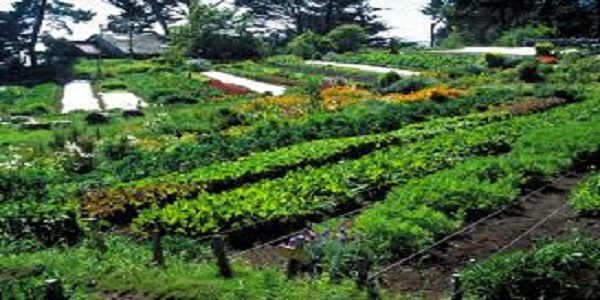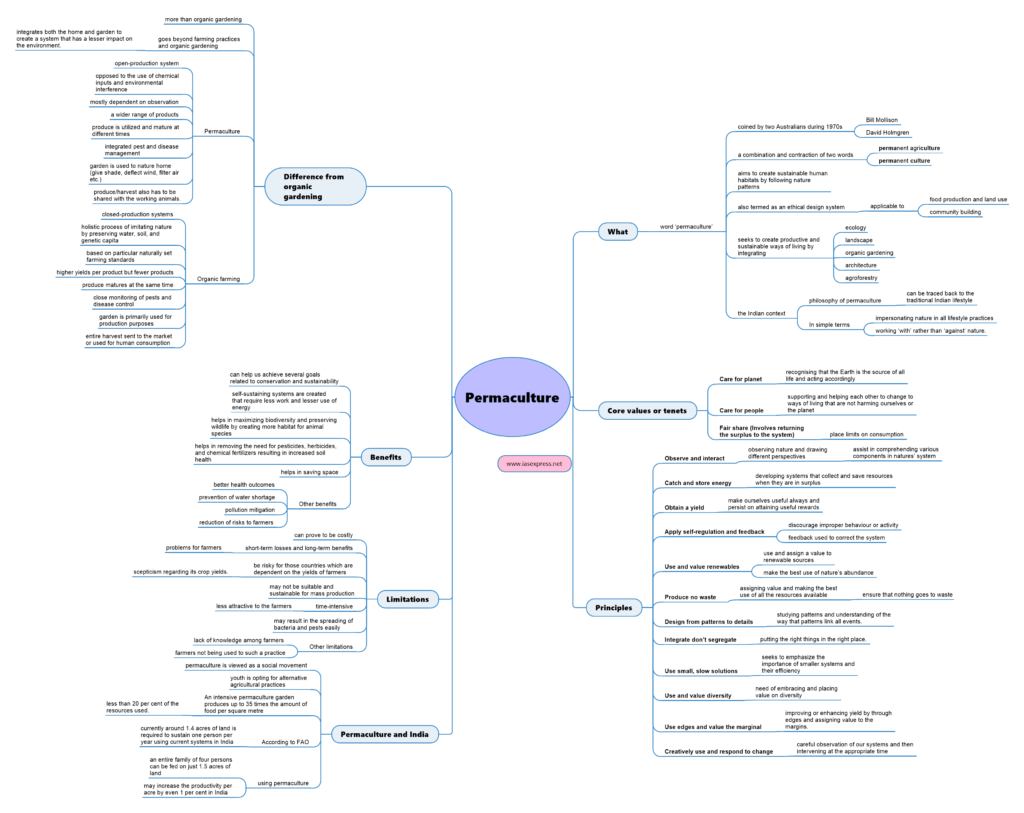Permaculture – Components, Benefits and Limitations

From Current Affairs Notes for UPSC » Editorials & In-depths » This topic
IAS EXPRESS Vs UPSC Prelims 2024: 80+ questions reflected
With growing awareness among people regarding the adaptation of sustainable farming practices and protecting the environment, several alternative ways of farming have become popular. One such practice which has become popular among people is permaculture. It is a climate-smart farming movement that would play a leading role in reducing the rapidly growing use of destructive, industrial-agricultural methods. It would be thus interesting to know what makes this practice climate-smart and sustainable in the long run.

What
- The word ‘permaculture’ was coined by two Australians named, Bill Mollison and David Holmgren during the 1970s.
- The word stands for a combination and contraction of two words permanent agriculture or permanent culture.
- It is a design system that aims to create sustainable human habitats by following nature patterns.
- It can be also termed as an ethical design system applicable to food production and land use, as well as community building.
- It seeks to create productive and sustainable ways of living by integrating ecology, landscape, organic gardening, architecture and agroforestry.
- In the Indian context, the philosophy of permaculture can also be traced back to the traditional Indian lifestyle.
- The principles of permaculture suggest observing and interacting with nature, obtaining a yield, capturing and storing energy, drawing from natural patterns, producing zero waste, accepting feedback and regulating self.
- In simple terms – impersonating nature in all lifestyle practices and working ‘with’ rather than ‘against’ nature.
Core values or tenets
- Care for planet
- It involves recognising that the Earth is the source of all life (and is possibly itself a living entity) and respecting her accordingly.
- Care for people
- This involves supporting and helping each other to change to ways of living that are not harming ourselves or the planet, and realizing that we are a part of the Earth, not apart from it.
- Fair share (Involves returning the surplus to the system)
- It seeks to place limits on consumption by ensuring that the Earth’s limited resources are utilized in ways that are equitable and wise.
Principles
- Observe and interact
- This involves observing nature and drawing different perspectives to assist in comprehending various components in natures’ system.
- Catch and store energy
- This principle stands for developing systems that collect and save resources when they are in surplus so that they can be used in times of need or when the resources become scarce.
- Obtain a yield
- This principle means that we have to ensure that we make ourselves useful always and persist on attaining useful rewards as part of the work that we do.
- Apply self-regulation and feedback
- This principle says that as humans we should consistently discourage improper behaviour or activity to ensure that systems continue to serve the right purpose and satisfactorily as they are intended to fulfil.
- This principle does away with negative feedback. It says that if there is any feedback, it should be used to correct the system.
- Use and value renewables
- This principle seeks to use and assign a value to renewable sources and teaches one to make the best use of nature’s abundance to reduce our consumption behaviour and reliance on non-renewable sources of energy.
- Produce no waste
- This principle says that assigning value and making the best use of all the resources available would ensure that nothing goes to waste. This would result in reducing spending, resource depletion, and dependence on new resources/materials/utilities.
- Design from patterns to details
- This principle says that our world is made up of patterns and by studying patterns and embracing the permaculture principle “observe and interact”, one can begin to achieve an understanding of the way that patterns link all events.
- The patterns that exist in nature make life self-sustaining and self-perpetuating, enable energy to flow and are a natural response to their surroundings. If one does not adhere to these natural patterns, he/she stops the flow of energy and cause more work and lower yields.
- The various patterns observed in nature and our society can be used as the pillar of our designs and improvements can be made as we make more and more observations.
- Integrate don’t segregate
- This principle stands for having things in order by putting the right things in the right place. This is because it believes that there exist associations between things and they normally work interchangeably to support each other.
- Use small, slow solutions
- This principle seeks to emphasize the importance of smaller systems and their efficiency.
- It says that small and slow systems are easier to manage compared to bigger ones, and contributes to better utilization of local resources and advancement of more sustainable outcomes.
- Use and value diversity
- This principle necessitates the need of embracing and placing value on diversity to reduce vulnerability to a variety of threats and to exploit as well as explore the uniqueness of nature.
- Use edges and value the marginal
- This principle talks about improving or enhancing yield by using the most diverse, valuable and productive components through edges and assigning value to the margins.
- Creatively use and respond to change
- This principle stands for careful observation of our systems and then intervening at the appropriate time with the most suitable measures.
How permaculture is different from organic gardening?
- Permaculture is often confused with organic gardening. However, it is something more than that for it involves a comprehensive and dynamic system and can be practised at different levels and in various ways.
- Furthermore, it goes beyond farming practices and organic gardening because it integrates both the home and garden to create a system that has a lesser impact on the environment.
- Permaculture is an open-production system where energy is effectively utilized by one element and passed on to be used by another element before exiting the system whereas organic agriculture usually involves closed-production systems.
- Organic farming is opposed to the use of chemical inputs and environmental interference whereas permaculture uses a holistic process of imitating nature by preserving water, soil, and genetic capital.
- Permaculture is mostly dependent on observation whereas organic farming is based on particular naturally set farming standards. This is the reason why permaculture is adaptable to various conditions.
- On the yield front, organic farming has higher yields per product but fewer products, while permaculture has a wider range of products namely food, recreation, fuel and habitat.
- In organic farming, the produce matures at the same time whereas in permaculture produce is utilized and mature at different times throughout the year.
- Organic farming involves close monitoring of pests and disease control whereas permaculture is all about integrated pest and disease management.
- In permaculture, the garden is used to nature home (give shade, deflect wind, filter air etc.) while in organic farming the garden is primarily used for production purposes.
- The water source in organic farming is used for irrigation whereas in permaculture it majorly determines the shape of the garden.
- Lastly, the entire harvest of organic farming is sent to the market or used for human consumption while in permaculture the produce/harvest also has to be shared with the working animals.
Benefits
- Permaculture can help us achieve several goals related to conservation and sustainability since it focuses on protecting natural resources and promoting the development of resilient communities that can withstand the effects of climate change and other global environmental challenges.
- Once the principles of permaculture are implemented, self-sustaining systems are created that require less work. This occurs because the natural flow of nature in these systems removes the need for intensive agricultural practice resulting in lesser use of energy.
- As permaculture involves offering solutions for soil fertility, water conservation, climate change mitigation, and animal habitat, it helps in maximizing biodiversity and preserving wildlife by creating more habitat for animal species.
- Permaculture involves the growing of diverse mixtures of perennial and annual plants that provide food for one another. This helps in removing the need for pesticides, herbicides, and chemical fertilizers resulting in increased soil health.
- Permaculture works well when one needs to create a small space with an intensive output. It thus helps in saving space.
- Other benefits include better health outcomes, prevention of water shortage, pollution mitigation, reduction of risks to farmers due to the absence of reliance on monoculture etc.
Limitations
- Permaculture can prove to be costly since it will require adjustments in agricultural processes and infrastructure making it difficult to be a part of mainstream life.
- Permaculture will lead to short-term losses and long-term benefits resulting in problems for farmers.
- The short-term losses include a significant amount of investment and waiting for an extensive period until they see the rewards.
- It might be risky for those countries which are dependent on the yields of farmers to ensure their food supply.
- This is because permaculture is a new concept and there is scepticism regarding its crop yields.
- If it does not deliver sufficient crop yields it may be disastrous for the local population.
- Permaculture may not be suitable and sustainable for mass production.
- It is time-intensive since it requires plenty of work to be done and the use of fewer machines. This may make it less attractive to the farmers.
- Permaculture does not involve the usage of chemical pesticides that may result in the spreading of bacteria and pests easily leading to the loss of crop yields.
- Other limitations include lack of knowledge among farmers regarding permaculture and farmers not being used to such a practice.
Permaculture and India
- Studies suggest that permaculture is viewed as a social movement and these characteristics are prevalent in India too.
- With rising awareness about the country’s agrarian crisis, the challenges faced by farmers and projected threats from climate change, the youth is opting for alternative agricultural practices.
- Around 40 per cent of all food produced is wasted in India. An intensive permaculture garden produces up to 35 times the amount of food per square metre when compared to a conventional farm, with less than 20 per cent of the resources used.
- Thus, permaculture may help in making every bio-region abundant.
- According to FAO, currently around 1.4 acres of land is required to sustain one person per year using current systems in India.
- However, by using permaculture, an entire family of four persons can be fed on just 1.5 acres of land.
- In India, permaculture may increase the productivity per acre by even 1 per cent, making a huge impact for providing resilience. Thus, it has a huge potential for India.
Conclusion
Although permaculture may not be a short-term solution for all the problems the farmers face, the role of permaculture in improving biodiversity, by increasing the spatial, vertical, and temporal diversity of species can be huge. The long-term benefits offered by permaculture may help human society in building a sustainable farming technique for themselves.
Practise question
Q. Can permaculture prove to be a beneficial alternative to Indian farmers against conventional farming techniques? Comment.
If you like this post, please share your feedback in the comments section below so that we will upload more posts like this.

